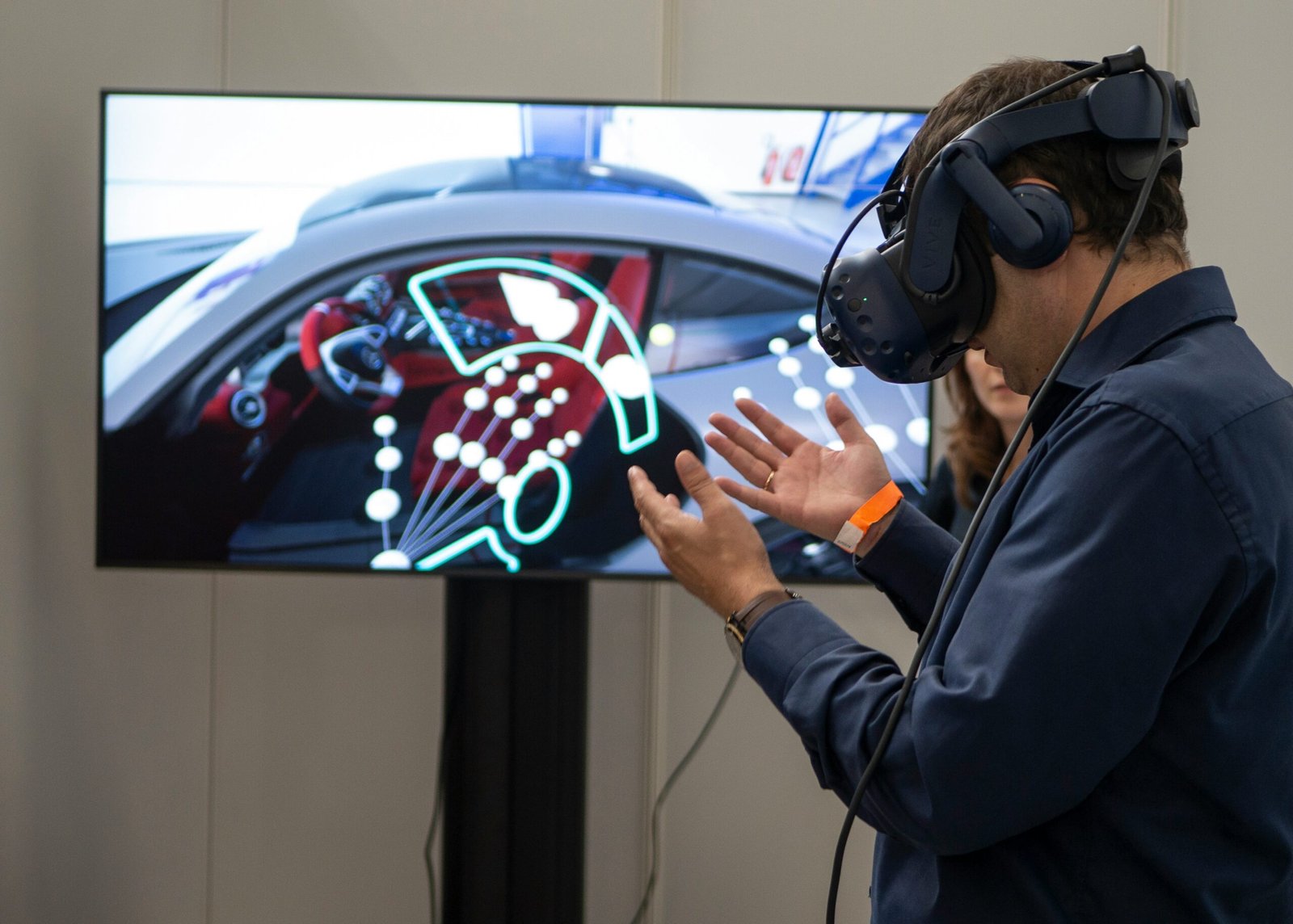
Introduction to Augmented Reality in Marketing
Augmented reality (AR) is a transformative technology that blends digital content with the real world, enhancing the user’s experience and interaction with their environment. By overlaying computer-generated images, sounds, and other sensory stimuli, AR creates immersive scenarios that alter how individuals perceive and engage with information. In the marketing sector, the application of AR has gained momentum, as brands seek innovative ways to connect with consumers and differentiate themselves in a saturated marketplace.
With the rapid advancements in AR technology, including improved mobile capabilities and accessible development tools, marketing professionals are beginning to recognize its potential as an effective engagement strategy. Companies are utilizing AR to create compelling campaigns that allow consumers to interact with products before making a purchase, thus reducing uncertainty and enhancing the overall buying experience. For instance, virtual try-on solutions in fashion and beauty sectors enable customers to visualize how a product looks in real life through their devices, thus providing an interactive shopping experience.
The significance of augmented reality in marketing has continued to grow, particularly with the increasing prevalence of smartphones and AR-compatible devices. This has led to the creation of various AR applications tailored for marketing purposes, which not only attract attention but also encourage consumers to take action. As brands harness this innovative technology to engage their target audiences, they are witnessing improved customer loyalty and higher conversion rates. Consequently, augmented reality is swiftly becoming an essential component of the marketing landscape, poised to reshape how brands communicate with their consumers and enhance their brand narratives.
The Rise of AR Advertising
In recent years, augmented reality (AR) advertising has emerged as a powerful tool for brands looking to enhance consumer engagement and create memorable marketing experiences. This innovative approach allows businesses to combine digital elements with the physical world, resulting in interactive campaigns that captivate audiences and foster deeper connections with products and services. Companies are recognizing the potential of AR to transform static advertisements into dynamic experiences.
One notable example is IKEA, which has successfully implemented AR technology in its marketing strategy. The IKEA Place app enables customers to visualize how furniture will look in their homes by using their smartphone cameras. This not only simplifies the decision-making process but also enhances the overall shopping experience. By providing an immersive visualization, IKEA has significantly influenced consumer behavior, leading to increased sales and customer satisfaction.
Another exemplary case is the beauty industry, where brands like L’Oréal and Sephora have embraced AR to revolutionize how consumers engage with their products. Through apps that use AR, customers can virtually try on makeup or hair colors before making a purchase. This interactive feature not only reduces the risk of dissatisfaction but also boosts confidence in buying decisions. The integration of AR technology has proven to be a game-changer in driving sales and creating a more personalized shopping experience.
Furthermore, AR advertising enables brands to collect valuable data about consumer interactions, which can inform future marketing strategies. By monitoring how users engage with the AR content, brands can tailor their approaches to increase effectiveness and refine their messaging. As businesses continue to innovate within the digital landscape, the rise of augmented reality in advertising signals a shift towards more immersive and engaging marketing experiences that align with evolving consumer expectations.
Personalization through Augmented Reality
In the realm of marketing, personalization has emerged as a key trend, and augmented reality (AR) plays a pivotal role in enhancing this experience for consumers. By leveraging user data and preferences, brands can create tailored interactions that resonate on an individual level, resulting in more engaging and meaningful marketing endeavors. AR technology enables consumers to interact with products in an immersive and personalized manner, fostering a deeper connection between the consumer and the brand.
One of the most significant advantages of augmented reality is its ability to provide customized experiences that cater to individual tastes and shopping habits. For instance, many retailers now offer AR applications that allow customers to visualize how products will look in their homes or on themselves. This virtual try-on experience can significantly reduce the uncertainty often associated with online shopping. For example, furniture retailers employ AR tools that let customers see how a piece of furniture fits within their living space, enhancing decision-making and increasing purchase confidence.
Moreover, brands are increasingly utilizing AR technology to create personalized marketing campaigns that adapt based on user behavior and preferences. Notable examples include fashion retailers that allow customers to scan clothing items with their smartphones to receive tailored recommendations based on their previous purchases or browsing history. This level of personalization not only improves customer satisfaction but also strengthens brand loyalty as consumers feel valued and understood.
As the augmented reality landscape continues to evolve, marketers will increasingly focus on creating personalized experiences that appeal to consumers’ unique preferences. By harnessing the power of AR to craft individualized interactions, brands can distinguish themselves in a crowded marketplace, ultimately leading to improved customer retention and advocacy.
AR and the Future of E-commerce
The integration of augmented reality (AR) technologies into e-commerce is poised to transform the online shopping experience significantly. By allowing customers to visualize products in their own environments before making a purchase, AR can bridge the gap between virtual browsing and tangible interaction. This experiential approach not only enhances the shopping experience but also reduces the uncertainty that often accompanies online purchases, leading to higher customer satisfaction and potentially increasing conversion rates.
As we look towards the future, several trends can be anticipated in the implementation of AR tools within e-commerce platforms. Retailers are likely to develop more sophisticated AR applications that provide detailed visualizations of products. For instance, consumers seeking furniture could utilize AR to view how an item would fit and appear within their home space. Similarly, brands might offer virtual try-on features for clothing and accessories, helping customers determine fit and style without the need for physical trials. The seamless integration of AR into mobile apps and websites is expected to become a standard, streamlining the consumer journey while fostering a more interactive shopping environment.
Furthermore, the proliferation of smart devices equipped with AR capabilities will drive the widespread adoption of this technology in e-commerce. As consumers become more accustomed to this mode of engaging with products, the demand for realistic AR experiences will increase. Retailers who invest in developing compelling AR solutions will likely benefit from a competitive edge, as they tap into a growing consumer base that values innovation and convenience. Overall, the evolution of augmented reality in the e-commerce sector presents exciting opportunities for brands to enhance customer engagement and loyalty, ultimately reshaping the dynamics of online shopping.
Enhancing Brand Storytelling with AR
Augmented reality (AR) has emerged as a powerful tool for brands seeking to enhance their storytelling capabilities. By integrating digital elements into the physical world, AR allows companies to create immersive narratives that engage consumers like never before. This transformative technology facilitates interactive experiences that not only captivate audiences but also deepen emotional connections, leading to increased brand loyalty and recall.
One notable example of AR in brand storytelling can be seen in the campaign by the cosmetic brand L’Oréal. They employed augmented reality to enable customers to virtually try on various shades of lipstick through their mobile app. This not only empowered consumers to make informed purchase decisions but also forged an emotional connection as they could visualize how the product would enhance their appearance. By turning a simple product demonstration into an interactive experience, L’Oréal successfully utilized AR to create a vivid narrative around beauty and self-expression.
Another compelling instance is illustrated by IKEA’s AR app, IKEA Place, which allows users to see how furniture would look in their own homes before making a purchase. This innovative application of augmented reality (AR) turns traditional shopping into an engaging journey. By allowing consumers to visualize potential purchases in their own environments, IKEA creates a narrative that emphasizes personalization and home decoration, effectively resonating with their target audience. Consumers can envision their dream space, transforming the often mundane shopping experience into one filled with excitement and anticipation.
The effectiveness of AR-enabled storytelling lies in its ability to create memorable experiences that resonate with consumers on a deeper level. By blending storytelling with interactivity, brands are fostering unique connections that transcend conventional advertising. As augmented reality continues to evolve, we can expect brands to increasingly leverage this technology to craft engaging narratives that not only inform but also inspire their audiences.
Challenges and Limitations of Augmented Reality in Marketing
As brands increasingly turn to augmented reality (AR) to enhance their marketing strategies, it is crucial to acknowledge the challenges and limitations associated with this technology. One of the primary technical challenges lies in the requirement for robust hardware and software capabilities. Many consumers may not own devices that can fully support high-quality AR experiences, leading to disparities in access. Consequently, marketers must ensure that their AR applications are compatible with a broad range of devices to reach a larger audience.
Moreover, internet connectivity can pose significant obstacles. A stable and high-speed connection is essential for seamless AR experiences; however, this may not be consistently available to all users. Brands must consider this infrastructure limitation when designing their AR campaigns, potentially incorporating offline features to maintain engagement regardless of internet access.
Consumer accessibility also extends to the understanding and comfort level with AR technology. While younger audiences may be more receptive to augmented reality experiences, older demographics might feel intimidated or uninterested, limiting the effectiveness of AR in marketing. To counteract this, brands should focus on providing clear guidance on how to interact with AR features, thus reducing any apprehensions that may arise among less tech-savvy consumers.
Another significant issue is the potential resistance from traditional marketing practices. Some companies may hesitate to fully embrace augmented reality due to skepticism regarding its effectiveness or ROI compared to well-established marketing strategies. To alleviate these concerns, businesses should conduct thorough research on audiences to identify the best contexts for AR use. By showcasing successful case studies and demonstrating tangible benefits, brands can foster a culture that embraces innovative marketing tactics.
In summary, while augmented reality has the potential to transform marketing strategies, companies must navigate technical, accessibility, and traditional resistance challenges effectively to harness its full capabilities.
The Role of Artificial Intelligence in AR Marketing
As businesses increasingly turn to innovative technologies for marketing, the combination of augmented reality (AR) and artificial intelligence (AI) has emerged as a powerful force. This integration not only enhances customer engagement but also allows for personalized experiences that drive conversion rates. Through sophisticated algorithms and machine learning, AI can analyze user behavior and preferences to deliver relevant content and smart recommendations within AR environments.
For instance, brands utilizing augmented reality can create interactive interfaces that tailor experiences based on real-time user data. By leveraging AI’s capabilities, companies can ensure that users see products that match their personal tastes and previous interactions. This personalized approach significantly elevates the shopping experience, making it more immersive and memorable. Through dynamically generated content, augmented reality can transform static advertisements into engaging narratives, where customers interact with 3D models that come to life through their devices.
Several case studies illustrate the effectiveness of this integration. A notable example is how IKEA employs both AI and AR through its app, “IKEA Place,” which allows users to visualize furniture in their homes before making a purchase. The AI component analyzes user input and suggests items that match their style, streamlining the decision-making process. Similarly, L’Oréal’s “Virtual Try On” feature utilizes AI algorithms to analyze facial features and provide users with personalized makeup suggestions through AR overlays. These case studies underline how the synergy of augmented reality and artificial intelligence can redefine marketing strategies, providing tailored consumer experiences that reflect individual needs.
In conclusion, embracing the convergence of AI and augmented reality in marketing not only enhances user engagement but prepares businesses for future trends that prioritize personalized and interactive content. As this synergy continues to evolve, it sets the stage for innovative marketing strategies that resonate with consumers on a deeper level.
Consumer Considerations and Privacy Concerns
As augmented reality (AR) continues to evolve within marketing strategies, it is essential for brands to address consumer considerations and the associated privacy concerns effectively. The integration of AR technology in consumer experiences often requires the collection of personal data, including location information, preferences, and usage patterns. This necessitates a careful approach to data handling, ensuring compliance with privacy regulations such as the General Data Protection Regulation (GDPR) and the California Consumer Privacy Act (CCPA).
To build consumer trust, brands must prioritize transparency regarding data collection practices. Clear communication about what data is being collected, how it will be used, and the duration of its storage is crucial. Brands should provide consumers with easy access to privacy policies, featuring straightforward language that demystifies technical jargon. Additionally, obtaining informed consent before any data collection is not just a legal requirement but also a cornerstone of ethical marketing practices.
Another important aspect is empowering consumers with control over their data. Brands should implement mechanisms that allow users to opt-in or opt-out of data sharing and enable them to delete their information upon request. Providing these options fosters a sense of agency and reassures consumers that their personal information is being managed responsibly.
Furthermore, it is advisable for brands to be proactive in educating users about the benefits of augmented reality experiences. Demonstrating how AR can enhance shopping interactions, product visualization, and overall engagement can shift the focus from concerns regarding data collection to the added value of the experience itself.
By embracing a consumer-centric approach that prioritizes privacy, brands can establish and maintain a positive perception of augmented reality marketing initiatives. This, in turn, will contribute to a more successful integration of AR into the marketplace.
The Future: Predictions for AR in Marketing
The realm of augmented reality (AR) in marketing is poised for transformative advancements as technology continues to evolve. Industry experts predict that the integration of AR will become increasingly sophisticated, allowing for more seamless user experiences. As hardware and software improvements take center stage, we can expect AR applications to become more accessible across various platforms, including smartphones, tablets, and AR glasses. This increased accessibility ultimately aims to provide richer, contextual content that enhances consumer engagement.
Market growth for AR in marketing is anticipated to expand significantly in the coming years. According to various reports, the global augmented reality market is forecasted to reach valuations surpassing several billion dollars, highlighting the urgency for brands to adopt AR strategies. This growth signals a shift in how businesses communicate with their target audiences, moving towards immersive experiences that captivate and influence consumer behavior in real-time. Marketers who leverage AR will likely gain a competitive edge by offering unique, interactive solutions that resonate with consumers’ desires for personalized engagement.
Moreover, evolving consumer expectations will shape the use of AR in marketing. Today’s consumers demand more tailored experiences that reflect their preferences. In response, brands are expected to utilize AR to create personalized advertisements and digital interactions, ultimately cultivating a more meaningful connection with their audiences. As AR technology permits the blending of digital content with real-world environments, it empowers marketers to design innovative campaigns that cater specifically to individual interests and needs.
As we look ahead, it is clear that the future of augmented reality in marketing holds immense potential. Marketers must remain vigilant and adaptable to these emerging trends, embracing the capabilities of AR to craft interactive experiences that drive engagement and conversion. Failure to do so may result in missed opportunities in a rapidly evolving marketplace.

